ISSN ONLINE(2319-8753)PRINT(2347-6710)
ISSN ONLINE(2319-8753)PRINT(2347-6710)
Abhishek Satwase 1, G.S.R.Sanjeevini 2
|
| Related article at Pubmed, Scholar Google |
Visit for more related articles at International Journal of Innovative Research in Science, Engineering and Technology
There are many load centres that are isolated from the main utility grid. Some of them are remote villages, islands, ships, etc. They require isolated electric supply by means of stand-alone electrical generators to provide for their local electrical loads. The proposed model is used for standalone system where the power is fed directly to the local loads for the applications where the connectivity to the grid is not possible. The system can also be made to work in combination with grid and local loads .In Islanding mode the generator supplies the local loads during the light load and during heavy load condition, the excess power is absorbed/ supplied by battery energy storage system (BESS) which is connected parallel to dc link capacitor. A three phase load, independent wind energy conversion system is employed using DFIG operated at variable speeds for supplying the power to local loads and also perform the function of load levelling and harmonic elimination.
Keywords |
| Doubly Fed Induction Generator, Wind Energy Conversion System, Battery Energy Storage System, Stator voltage, MPT, Parallel operation. |
INTRODUCTION |
| In simple terms, a stand-alone generator refers to an isolated grid feeding a local load [2]. In the case of gridconnected variable-speed wind turbines, the total active power can be fed to the grid. For stand-alone systems that supply local loads, if the extracted wind power is more than the local load demand (including losses), the excess power from the wind turbine needs to be diverted to dump load or can be stored in a battery bank. Likewise, when the power extracted is less than the load at the consumer end, the remaining power needs to be supplied from a storage element like a flywheel, a super capacitor, compressed air, hydrogen storage, a secondary battery, etc. [3]. |
| For the variable-speed operation using DFIG based wind turbines, the speed of the generator is varied within a certain limit (below and above synchronous speed), and only the slip power is needed to be handled by the converter interface, which is only a fraction of the total system power, thus considerable amount of power is saved . By the use of two back-to-back pulse width-modulated (PWM) insulated-gate bipolar-transistor (IGBT)-based voltage source converters (VSCs), the bidirectional active power flow capability is achieved .These converters have a common capacitive dc link. These two converters are thereby referred to as the rotor-side converter and the stator-side converter. Considerable work has been done on the operation of DFIG's connected to the grid and also on its applications for variable-speed wind energy conversion system (WECS) [4]–[7], [16]. On the other hand, in the case of stand-alone systems, the voltage and frequency control issues have been mentioned by some researchers. Some experimental work has also been reported for stand-alone systems using DFIG [2], [8], [9]. The stand-alone generation systems with hybrid topology of wind–diesel have also been reported in the literature [10], [11], [18]. A lot of efforts have been made to address the issues of voltage and frequency control for isolated systems using asynchronous/induction generators [12]–[15], [19]. Battery-based controllers are proposed for control of voltage and frequency in the isolated wind energy conversion systems in [13], [14] and [17]. However, in these battery-based isolated systems based on squirrel cage asynchronous generators (SCIG) that operate at almost constant speeds, maximum power tracking (MPT) could not be accomplished. |
SYSTEM DESCRIPTION |
| A simplified diagram of the proposed isolated wind energy conversion system (WECS) operating in parallel with two DFIG's that employ three voltage source converters that are IGBT based and operate on the principle of pulse width modulation (PWM) is shown in the fig 3.The DFIG's have two converters on the rotor side, which are useful for maximum power tracking (MPT) which can be achieved by controlling rotor speed. At the stator end of the DFIG, we have the stator side converter and there is a common dc bus battery bank along with the rotor side converter. Between the stator end and the stator side converter, a transformer (star-delta) is connected for eliminating harmonics and optimising the dc bus voltage. For the single phase load operation, a neutral point is provided on the star (Y) side of the transformer. |
| In order to achieve quick dynamic response, controlling of the converters is done by the stator flux oriented control by dissociating the q (active) and d (reactive) components of total stator currents and rotor currents of both the DFIG's. The total stator current means the addition of stator currents of both the DFIG's. |
| The task of the battery energy storage system, in short (BESS) is load levelling which is needed in the case of variable loads and uncertain wind speeds. As already mentioned, this BESS is provided at the dc bus of the converters. The location of the BESS proves to be advantageous in the sense that for the power transfer process to or from the battery, no extra converter is needed. The battery also helps in keeping the dc bus voltage constant at the time of load disturbances or load fluctuations. In order to remove ripples from the current from the battery, an inductive filter is connected in series with it. |
| For the designed wind energy conversion system (WECS), the new algorithm would be able to perform many functions like load levelling, harmonic elimination, MPT, and most importantly control of voltage and frequency at the stator end. |
 |
MATLAB BASED MODELLING |
| Using MATLAB/Simulink and SPS tool box, a model for the isolated wind energy conversion system (WECS) is developed (fig 3). The simulation is done on the MATLAB's 7th version with ode 3 solver. SPS (Sim Power Systems) is used for electrical systems and for measurements .Both balanced and unbalanced loads are applied and the behaviour of dc battery bank voltage, load power, load currents under sub-synchronous, synchronous and supersynchronous modes of operation are observed. A brief account of the equations for the turbine and the battery bank is given below. |
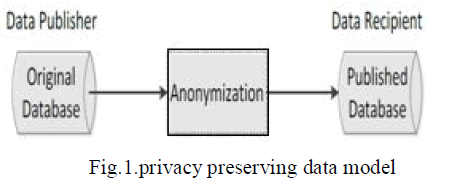 |
| Figure 3. Simulink model developed using SPS |
SIMULATION RESULTS |
| The performance of the proposed WECS under different load conditions is demonstrated, simulated and discussed below. Functioning of the wind turbine-cum-battery energy storage system for steady state and dynamic wind speed is separately discussed. As mentioned earlier, under steady state condition, there are three modes of operation of a wind turbine i.e. synchronous mode, sub synchronous mode and super synchronous mode. For all the three modes of operation simulation is done and the obtained result is shown separately. For all the above mentioned cases graphs of load voltage (VL ), load current (IL), active power consumed at the load (P), reactive power required at load side (Q), energy status of the battery (Vdc in p.u.) and the battery current (Idc) is plotted with respect to time. Let the speed of wind is 8m/s for synchronous mode of operation and under the balanced condition the total power consumed by the load is assumed to be 24 KW and this power is assumed to be divided equally among three phases, i.e. 8 KW per phase. Similarly the reactive power that is required at the load end is assumed to be 1kvar and assumed equally divided among the phases. Also let the Battery Energy Storage system (BESS) is half charged (i.e. power stored in the BESS is 0.5 pu). |
| As soon as wind starts blowing the blades of turbine start rotating and when the wind speed achieves a minimum level of 6m/s energy is being generated by the turbine. The system is designed to track maximum power condition always, called Maximum Power Tracking (MPT) capability of the WECS. During the transient period when the turbines and DFIGs are accelerating, the battery charging current reduces. After a few cycles, the currents settle to the steady-state values. Each of the wind turbines is able to maintain its maximum coefficient of performance of 0.4412 irrespective of the wind speed, and the speeds of DFIGs settle to the speeds corresponding to MPT in a few cycles. Thus, WECS is able to deliver power at constant voltage and frequency irrespective of the wind speed and extracts power from the wind corresponding to MPT point. The transient condition can be discussed later. The movement of rotor and the position of rotor with respect to static position is also simulated and plotted with respect to time. |
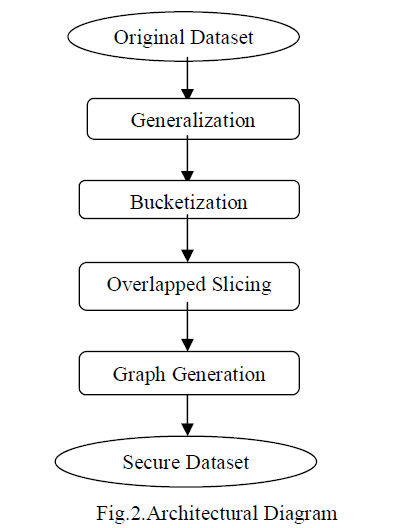 |
| Figure 4.1 Rotor Speed and Rotor angle of the two DFIGs |
| Synchronous Mode of Operation |
| A wind turbine is said to be operated in the synchronous mode when the speed of wind is nearly same as the speed required for Maximum Power Tracking (MPT). In this case power generated by the Isolated Wind Energy Conversion System (WECS) is approximately same as the power required at the load end. |
| For Balanced Load |
| As assumed above, for synchronous mode of operation, the wind speed is assumed constant i.e. 8m/s and the total power (active and reactive both) is divided equally among the three phases. It is clearly seen from the simulation result obtained, the load voltage, VL and load current IL are constant as well as active and reactive power required. Since the mode of operation assumed here is Synchronous, the power demand is almost met by the power generated hence the Battery Energy Storage system (BESS) will be almost constant i.e. 0.5 pu. Since there is no charging or discharging of the battery, current flowing through the battery is zero. |
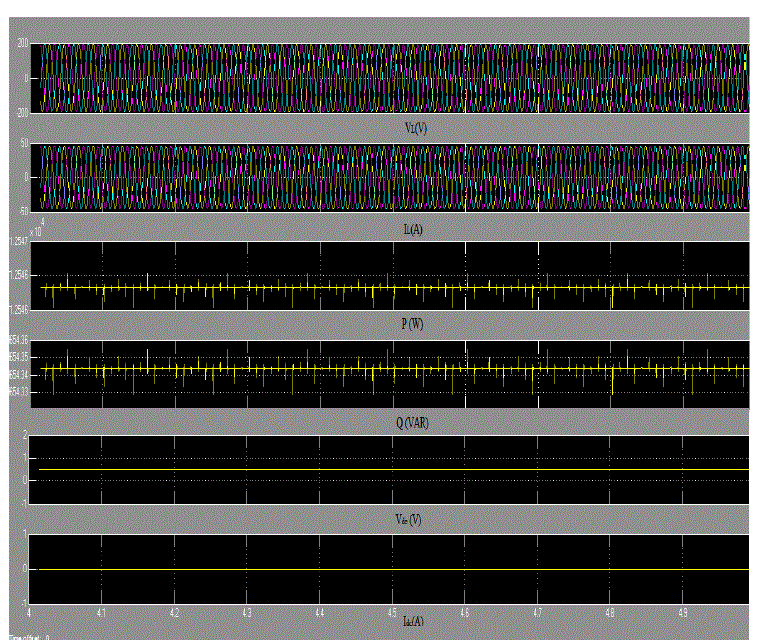 |
| Figure 4.2 Simulation results of WECS for synchronous mode under balanced load condition (at wind speed 8m/s) |
| Super Synchronous Mode of Operation |
| A wind turbine is said to be operated in the super synchronous mode when the speed of wind is more than the speed required for Maximum Power Tracking (MPT). In this case power generated by the Wind Energy Conversion System (WECS) is more than the power required at the load end. |
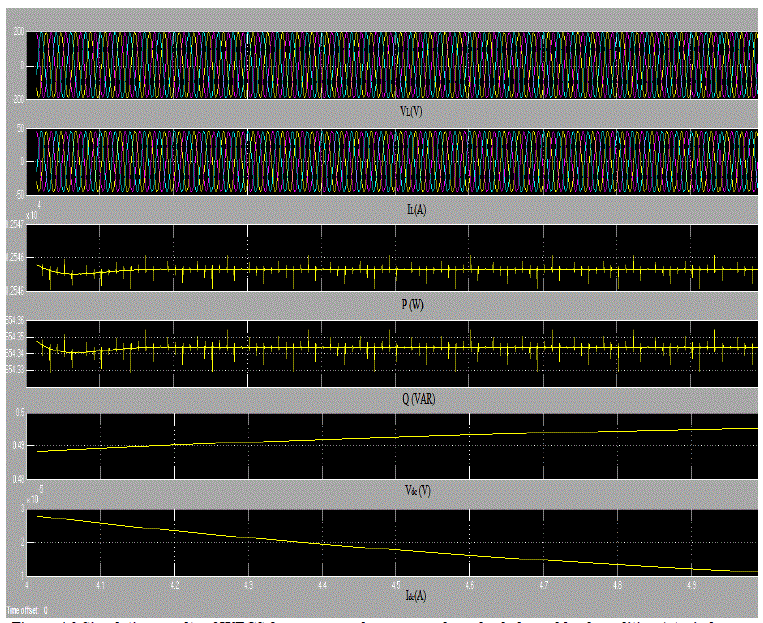 |
| Figure 4.3 Simulation results of WECS for super synchronous mode under balanced load condition (at wind speed 10m/s) |
| Since the power generated in this case is more than the power required at the load end, extra power is diverted to the BESS. It is clearly seen from the simulation result Vdc and Idc. The battery is charged from its initial assumed value of 0.5pu. |
| Sub Synchronous Mode of Operation |
| A wind turbine is said to be operated in the sub synchronous mode when the speed of wind is less than the speed required for Maximum Power Tracking (MPT). In this case power generated by the Wind Energy Conversion System (WECS) is less than the power required at the load end. |
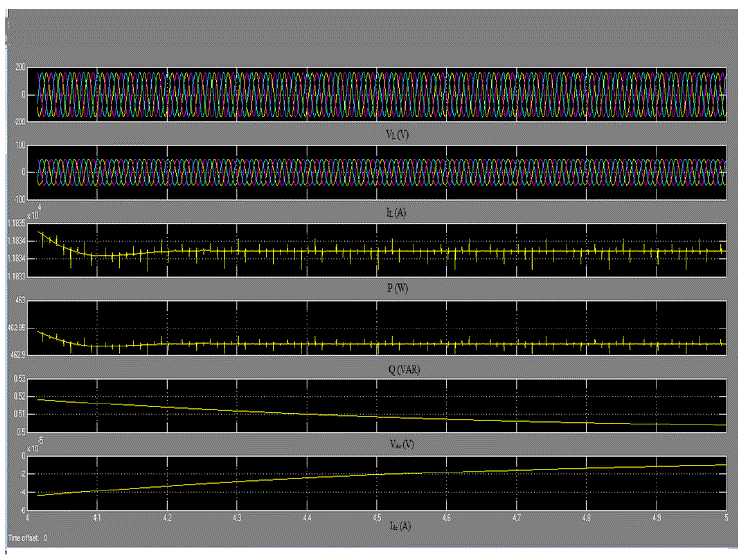 |
| Figure 4.4 Simulation results of WECS for sub synchronous mode under balanced load condition (at wind speed 6m/s) |
| Since the power generated in this case is less than the power required at the load end, extra power needed to maintain the frequency and voltage of the system in balanced condition is taken from the BESS. It is clearly seen from the simulation result Vdc and Idc. The battery is discharged from its initial assumed value of 0.5pu. |
CONCLUSION |
| The performance of the proposed wind energy conversion system under different conditions (sub synchronous, synchronous and super synchronous), balanced load is studied. A new wind energy conversion system (WECS) using two parallel operated DFIGs has been designed, modelled, and simulated in MATLAB using Simulink and SPS toolboxes. The performance of the proposed wind energy conversion system (WECS) has been demonstrated under different electrical (consumer load variation) and mechanical (with wind speed variation) dynamic conditions. It has been observed that the WECS demonstrates satisfactory performance under different dynamic conditions while maintaining constant voltage and frequency. Moreover, it has shown capability of MPT. |
References |
|